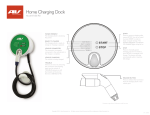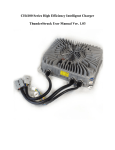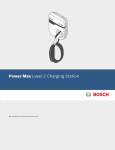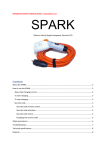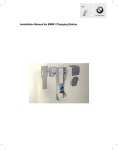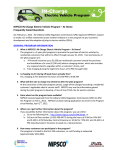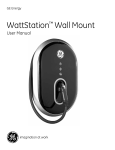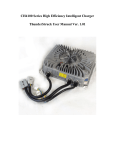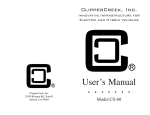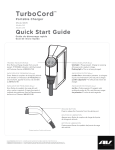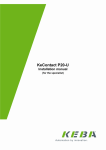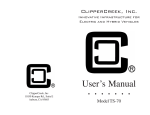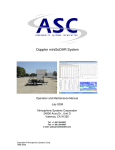Download USER GUIDE - EV Solutions
Transcript
100% electric USER GUIDE with Installation Instructions for Your Electrician AeroVironment™ EV Solutions™ Charging Dock Model EVSE-RS NOTICE TO ELECTRICIAN: Leave this User Guide with the evse-rs customer for future reference. © 2010-2011 AeroVironment, Inc. All rights reserved. AeroVironment, EVSE-RS, EV Solutions, and the AeroVironment logo are trademarks of AeroVironment, Inc. Nissan, the Nissan logo, the Zero Emission logo, and LEAF are trademarks or registered trademarks of Nissan Motor Co., Ltd., used with permission. Corporate names, trademarks, registered trademarks, service marks, symbols, and logos stated herein are property of their respective companies. Specifications are subject to change without notice. Images of the Charging Dock Model EVSE-RS are representative; production models may vary. No portion of these materials may be duplicated, used or disclosed without prior written permission from AeroVironment, Inc. Disclaimer: This user guide includes the latest information available at the time of printing. AeroVironment, Inc. reserves the right to make changes to this user guide and/or product without further notice. Changes or modifications to this product not completed by an authorized service provider could void the product warranty. AeroVironment, Inc. 181 W. Huntington Drive, Suite 202 Monrovia, CA 91016 Phone: 626-357-9983 or 888-833-2148 Fax: 626-359-9628 www.avinc.com/evsolutions Corporate email: [email protected] i Customer Support Before contacting Customer Support, write down the Serial Number of the Charging Dock. OWNER’S RECORD As you stand facing the Charging Dock, look for the Serial Number underneath left side of the enclosure. model: EVSE-RS Customer Support Phone: 1-877-NO GAS EV (1-877-664-2738) Customer Support email: [email protected] Serial number (s/n) : on label underneath left side of Charging Dock enclosure/housing This user guide is also available in Spanish, French, Chinese and Japanese For more information purchase date : AeroVironment, Inc. 181 W. Huntington Drive, Suite 202 Monrovia, CA 91016 Phone: 626-357-9983 or 888-833-2148 Fax: 626-359-9628 www.avinc.com/evsolutions Corporate email: [email protected] Document Number: EVSE-RS_UG_ENG_rev A 2-17-11 ii table of contents Getting Started......................................................... 1 Automatic charge starts.................................................21 Electric Vehicle Compatibility......................................... 3 Charge complete..............................................................22 Features.................................................................................. 3 Interrupt a charging cycle..............................................23 Important Safety Instructions........................................ 4 Remove and return connector to Charging Dock...27 Symbol Usage..................................................................... 4 Auto-Restart........................................................................29 High Voltage Warning....................................................... 6 Power Outage Recovery................................................ 30 FCC Information...............................................................10 Care and Maintenance.....................................................32 Safety Features..................................................................11 Time of Use Metering.......................................................32 Ventilation...........................................................................13 Operation.......................................................................15 Overview................................................................................16 Key Features........................................................................17 Charging your vehicle......................................................18 Check indicator lights.....................................................18 Disengage the connector..............................................19 Connect to vehicle...........................................................20 Troubleshooting.................................................. 33 Installation (for electrician only). ....47 Introduction........................................................................ 48 Safety Instructions............................................................49 Personal Protection Equipment (PPE)......................51 Package Contents.............................................................52 Front Panel and Enclosure............................................ 54 table of contents iii Installing the Charging Dock....................................... 55 Install a 40 amp circuit breaker....................................75 Obtain permits................................................................. 55 Turn the power ON..........................................................75 Building codes................................................................. 55 Self test...............................................................................77 Check parts in the package..........................................57 Inspection...........................................................................78 Tools.................................................................................... 58 To Re-Open the Charging Dock Location..............................................................................59 (electrician only)................................................................79 Choose wiring entry....................................................... 60 Route wiring and/or conduit.........................................61 Use mounting plate as template...................................61 Install mounting plate......................................................62 Drill holes........................................................................... 63 Appendix. .........................................................................82 specifications.......................................................... 83 warranty....................................................................... 84 Pull wires out of wall....................................................... 63 Remove cover and hang on rim of Charging Dock... 64 Attach Charging Dock to mounting plate................. 65 Upper mounting hole...................................................... 66 Lower mounting hole.......................................................67 Connect conduit to Charging Dock........................... 68 Connect utility wires and conduit............................... 68 Final assembly...................................................................70 Mount cable hanger to wall stud or dry wall.............73 iv table of contents index....................................................................................87 chapter 1 getting started Chapter 1 1 getting started Thank you for purchasing the AeroVironment Charging Dock Model EVSE-RS for use with your Nissan LEAF all-electric vehicle. This user guide shows how to use the Charging Dock and contains installation instructions for the electrician. AeroVironment recommends that your Charging Dock be installed by a licensed, qualified electrician. To avoid serious injury or death, installation must be in accordance with the WARNing manufacturer’s installation instructions and must comply with the provisions of the National Electric Code (NEC) and all local codes. In cases of conflict between local codes and the NEC, local codes shall take precedence. 2 getting started Chapter 1 Electric Vehicle Compatibility The Charging Dock is designed to charge all SAE J1772 compliant vehicles including Electric Vehicles (EVs) and Plug-In Hybrid Electric Vehicles (PHEVs). SAE J1772 is an electric vehicles charging standard that has been developed by the Society of Automotive Engineers, the governing body of Automotive Standards in the USA. The Charging Dock requires either a 240 VAC split phase and neutral grounded circuit or a 208 VAC 2 phases and neutral grounded circuit. This circuit must be routed directly from the power distribution panel to the Charging Dock location. Features • SAE J1772 Compliant • Underwriters Laboratory (UL) compliant • Auto-restart in event of power outage or • Breakaway safety cable ground fault • Integrated cable stowage with cable hanger • Optional pedestal mount • Quick read status indicators Chapter 1 getting started 3 important safety instructions Please read these Important Safety Instructions and the charging instructions in your vehicle owner’s manual before charging your electric vehicle. Failure to do so can result in death or serious injury. Save this user guide for future reference. There are many safety features built into the Charging Dock. Read all the safety information and warnings in this guide to be aware of any hazards and risks associated with installing and using the Charging Dock. notE Note any missing parts and contact AeroVironment Customer Support for assistance with obtaining replacement parts. Symbol Usage Take special note of all information marked with the following symbols: 4 getting started Chapter 1 Indicates information about safety practices which, if not followed, will result in death or serious injury. Indicates information about safety practices which, if not followed, could result in personal injury or are necessary to prevent fire or equipment overheating. Indicates helpful information for installation or usage, but does not contain personal injury or equipment safety related information. DANGER WARNING note These symbols may also be found on labels affixed to your Charging Dock. Chapter 1 getting started 5 High Voltage Warning danger High voltage is present in your electric meter housing and power distribution service panel. Contact with high voltage can cause death or serious personal injury. AeroVironment recommends that your Charging Dock be installed by a licensed, qualified electrician. To avoid serious injury or death, installation must be in accordance with the WARNING manufacturer’s installation instructions and must comply with the provisions of the National Electric Code (NEC) and all local codes. In cases of conflict between local codes and the NEC, local codes shall take precedence. 6 getting started Chapter 1 To clean the Charging Dock, wipe the Charging Dock with a clean cloth dampened with water or a mild detergent solution suitable for use on automobile paint. Do not use chemicals or solvents. Do not submerge the Charging Dock. Turn off the power to the Charging Dock at WARNING the circuit breaker and disconnect switch (if applicable) before cleaning it. Do not operate your Charging Dock with a visibly damaged output cable or module housing. Visually inspect the output cable (including the connector) and module housing for damage before each use. If you detect any damage, stop using the Charging Dock and contact danger Customer Support for service. If, at any time, you think the equipment is unsafe, shut off the electricity at the circuit breaker or disconnect (if applicable) and immediately contact Customer Support for service. DO note NOT use your Charging Dock until the problem is identified and corrected. Chapter 1 getting started 7 ALWAYS position the Charging Dock output cable so that it will not be driven over, stepped waRNING on, tripped over, or otherwise damaged or stressed while in use. To prevent personal injury and damage to the Charging Dock and cable, ALWAYS stow the output cable after use. STRANGULATION HAZARD. Small children could become entangled in the output cable waRNING and be strangled. Keep small children away from the Charging Dock, and ALWAYS stow the output cable after use. The Charging Dock is intended to be used by licensed drivers only. Children should not be waRNING allowed to use this Charging Dock. DO NOT allow children to play in or around the Charging Dock. Close supervision of children is necessary when the Charging Dock is used. 8 getting started Chapter 1 Use this Charging Dock to supply power to Electric Vehicles equipped with a compatible vehicle receptacle only. For more information, see the vehicle owner’s manual. waRNING State of California Proposition 65 Warnings: • This product contains a chemical known to the State of California to cause cancer. • This product contains a chemical known to the State of California to cause birth defects waRNING or other reproductive harm. Chapter 1 getting started 9 FCC Information This device complies with Part 15 of the FCC Rules. Operation is subject to the following two conditions: 1. This device may not cause harmful interference. 2. This device must accept any interference received, including interference that may cause undesired operation. Important! Changes or modifications to this product by anyone other than an authorized service provider will void FCC compliance. 10 getting started This product has been designed to protect against Radio Frequency Interference (RFI). However, there are some instances where high powered radio signals or nearby RF producing equipment (i.e. digital phones, RF communications equipment, etc) could affect operation. If you suspect your Charging Dock is receiving interference, take the following steps before contacting Customer Support for service: 1. Relocate nearby electrical appliances or equipment during charging. 2. Turn off nearby electrical appliances or equipment during charging. Chapter 1 safety features The Charging Dock is designed with your safety as the highest priority and includes the following convenient safety features to protect against the risk of electric shock: • • The Charging Dock is designed with a permanent grounding system for personal safety. The Charging Dock constantly checks for the presence of a service ground connection. If the service ground ever fails, the Charging Dock TROUBLE light turns ON and shuts power OFF to the vehicle. • The Charging Dock is equipped with a Ground Fault Circuit Interruption (GFCI) reaction system to protect against electric shock. If the module detects an output ground fault, it will shut off power to the output cable and illuminate the TROUBLE light. • The Charging Dock enclosure and cable assembly are completely insulated (no exposed live parts) to protect against electric shock. • The Charging Dock connector and EV coupler are designed to minimize unintentional disconnection and to prevent exposing the user to live power if an unintentional disconnection occurs. Chapter 1 getting started 11 • Pilot wires in the cable and connector eliminate the possibility of electric shock when not connected to a vehicle or if an unintended disconnect occurs during a charge. • When the Charging Dock connector is properly connected to the vehicle receptacle, the vehicle drive system is disabled. The output cable has a safety break-away feature in case the vehicle is moved or unintentionally rolls away from the parking location with the cable connected to the vehicle. The safety break-away feature will allow output cable separation from the Charging Dock if the output cable is yanked or pulled with excessive force. • The Charging Dock cable should be coiled up on the hanger when not in use to minimize potential cable damage and to eliminate the possibility of tripping over the cable. If the cable becomes separated from the Charging Dock. DO NOT attempt to repair or danger service the Charging Dock and cable assembly yourself. There are no user serviceable components inside. 12 getting started Chapter 1 Only a service technician authorized by AeroVironment can perform repair or service on the Charging Dock or the Charging Dock Warranty may be invalidated. Contact Customer note Support for service. Ventilation The AeroVironment (AV) Charging Dock will not work with Electric Vehicles (EVs) that require an external ventilation system. If the Charging Dock is connected to this type of EV, the Charging Dock will illuminate the TROUBLE light and not provide power to the vehicle. Contact Customer Support for additional information. Chapter 1 getting started 13 14 Chapter 1 chapter 2 operation Chapter 1 getting started 15 overview All the lights on the front panel are green when they turn on except the TROUBLE light which is red. POWER PRESENT Light turns on when power from your local utility is at the Charging Dock. This light should always be on if the circuit breaker and disconnect switch are both ON. (Disconnect switch may be required by local permitting authority but may not always be present.) vehicle connected This light turns on when the Charging Dock is communicating with your vehicle and the connection was made properly. ready to charge This light turns on when the Charging Dock is ready to be connected to your vehicle. vehicle charging This light turns on when power from the utility company is being provided to your vehicle. The light may stay on solid in the early stage of the charging cycle (if vehicle battery is low), then blinks later in the charging cycle, then finally goes out when charging is complete. trouble This light turns on when Charging Dock has detected an error and requires you to take action. See the Troubleshooting chapter on page 33. 16 oper ation CHAP TER 2 key features STArt (resume) stop (pause) Interrupts the charging cycle at any time. If vehicle is connected to the Charging Dock, press START to resume charging. To resume charging after the STOP button was pressed. Also, to override a random time delay after a utility power outage. storage dock connector Connector inserts into Charging Dock here and stays in place for storage when not in use. front panel Latch release connector Communicates between Charging Dock and vehicle and delivers power to vehicle. latch release cable hanger When cable is not being used, coil the cable over the cable hanger. Press to release connector. Then remove connector from Charging Dock. Also, when connector is plugged into vehicle, press latch release to stop power flowing to vehicle. Then, remove connector from vehicle. The connector will not disengage unless you depress the latch and stop the flow of electricity. CHAP TER 2 cable hanger cable oper ation 17 charging your vehicle 1. Check indicator lights First, make sure the POWER PRESENT and READY TO CHARGE lights are ON as shown below. This means that the Charging Dock is ready to charge your vehicle. note POWER PRESENT If the POWER PRESENT and READY TO CHARGE READY TO CHARGE lights VEHICLE CONNECTED are not ON, please see the VEHICLE CHARGING Troubleshooting chapter for TROUBLE possible solutions on page 34. 18 oper ation CHAP TER 2 2. Disengage the connector Press the latch release and remove the connector from the Charging Dock. Latch release CHAP TER 2 oper ation 19 3. Connect to vehicle Latch release Plug the connector into your vehicle’s charging receptacle and let go of the connector. Latch release will click to indicate proper connection. The connector should not disconnect without pressing the latch release. The connector stays in place. The VEHICLE CONNECTED light turns ON when a proper connection is made. POWER PRESENT READY TO CHARGE VEHICLE CONNECTED VEHICLE CHARGING TROUBLE 20 oper ation CHAP TER 2 4. Automatic charge starts The vehicle automatically starts charging and the Charging Dock supplies power as needed. • POWER PRESENT, VEHICLE CONNECTED, and the VEHICLE CHARGING lights stay on when charging • VEHICLE CHARGING light blinks when the vehicle is approaching the end of the charging cycle • VEHICLE CHARGING light goes out when POWER PRESENT vehicle is fully charged. Look for a gauge on READY TO CHARGE the vehicle that verifies that the vehicle is fully charged. See the owner’s manual that VEHICLE CONNECTED came with the vehicle to find out where the VEHICLE CHARGING gauge is located. TROUBLE CHAP TER 2 oper ation 21 5. Charge complete When the vehicle has completed charging, the VEHICLE CHARGING light turns OFF, the POWER PRESENT, READY TO CHARGE, and VEHICLE CONNECTED lights turn ON as shown below. POWER PRESENT READY TO CHARGE VEHICLE CONNECTED VEHICLE CHARGING TROUBLE 22 oper ation CHAP TER 2 6. Interrupt a charge cycle You can interrupt charging at any time using one of the two following methods: METHOD 1 (Preferred) Press the STOP button. After pressing STOP, the POWER PRESENT, READY TO CHARGE, and VEHICLE CONNECTED lights appear as shown. The VEHICLE CHARGING light goes OFF. Press the START button to resume charging. stop (PAUSE) start (resume) POWER PRESENT blinking READY TO CHARGE VEHICLE CONNECTED off VEHICLE CHARGING TROUBLE CHAP TER 2 oper ation 23 Once charging has resumed, the POWER PRESENT, VEHICLE CONNECTED, and VEHICLE CHARGING lights are ON as shown below: POWER PRESENT off READY TO CHARGE VEHICLE CONNECTED on VEHICLE CHARGING TROUBLE 24 oper ation CHAP TER 2 METHOD 2 Press the latch release on the connector to stop the flow of electricity and remove from the vehicle as shown below. Charging stops. Latch release CHAP TER 2 oper ation 25 The POWER PRESENT and READY TO CHARGE lights are ON as shown below. POWER PRESENT READY TO CHARGE VEHICLE CONNECTED VEHICLE CHARGING TROUBLE 26 oper ation CHAP TER 2 7. Remove and return connector to Charging Dock When the charge cycle is complete, press the latch release and remove the connector from your vehicle. Return the connector to the Charging Dock. The VEHICLE CHARGING light will be OFF. Latch release CHAP TER 2 oper ation 27 ALWAYS position the Charging Dock output cable so that it will not be driven over, stepped waRNING on, tripped over, or otherwise damaged or stressed while in use. To prevent personal injury and damage to the Charging Dock and cable, ALWAYS stow the output cable after use. STRANGULATION HAZARD. Small children could become entangled in the output cable waRNING cable hanger and be strangled. Keep small children away from the Charging Dock, and ALWAYS stow the cable output cable after use. 28 oper ation CHAP TER 2 auto-restart Auto-Restart feature helps ensure that your vehicle will be charged and ready for use when needed. If a charge is interrupted due to a temporary error condition, the Charging Dock automatically clears any error codes when the cause of the temporary error condition returns to normal and then attempts to restart the charge. The TROUBLE light remains lit while the cause of the temporary error condition is active or awaiting a time-out delay. The exception to immediate Auto-Restart is when the interrupt is due to a GFCI event. To allow charging after GFCI events caused by line surges or other disturbances, the Charging Dock will POWER PRESENT restart 15 minutes after a GFCI event, assuming the READY TO CHARGE event did not occur immediately upon connecting power to the vehicle. The Charging Dock is limited VEHICLE CONNECTED to four automatic restarts after a GFCI event during VEHICLE CHARGING a charge cycle. After the fourth attempt, the TROUBLE Charging Dock will shut down and the TROUBLE light will be ON. This light goes out when Auto-Restart is successful CHAP TER 2 oper ation 29 power outage recovery If there is a power outage, the utility grid might experience a large surge from multiple Charging Docks in your area attempting to resume charging simultaneously when power is restored. This would cause additional stress to the utility grid. The “Power Outage Recovery” feature avoids this scenario by resuming charge with an automatic delay after restoration of power. Power Outage Recovery ensures that Charging Dock users in your area will resume charging in a staggered fashion to avoid stressing the grid. If a utility power outage occurs while your vehicle is being charged, the charging dock will automatically resume charging once power POWER PRESENT is returned. The VEHICLE CHARGING light READY TO CHARGE blinks and charging will re-start automatiVEHICLE CONNECTED cally after a randomly assigned time ranging blinks VEHICLE CHARGING from 0 to 20 seconds. after power is restored 30 oper ation TROUBLE CHAP TER 2 To override the automatic (random) delay after utility power is restored, press the START button on the Charging Dock to resume charging. POWER PRESENT READY TO CHARGE START (RESUME) VEHICLE CONNECTED VEHICLE CHARGING TROUBLE CHAP TER 2 oper ation 31 Care and Maintenance To clean the Charging Dock module, wipe the Charging Dock with a clean cloth dampened with water or a mild detergent solution suitable for use on automobile paint. Do not use chemicals or solvents. Do not submerge the Charging Dock. Time of Use Metering Many electric utilities have been actively promoting the use of EVs and have developed specific utility rates to promote off-peak charging of these vehicles. This approach typically requires a second meter to separately monitor the electrical use of the Charging Dock. This allows the utility to charge rates on a ‘Time of Use” (TOU) basis, typically providing savings for overnight (off peak) charging and penalties for daytime (on peak) charging. Consult your local electric utility to determine Time of Use availability and cost. 32 oper ation CHAP TER 2 chapter 3 troubleshooting CHAP TER 2 oper ation 33 If you experience difficulty with your Charging Dock or your vehicle battery does not charge properly, please read this Troubleshooting section for possible solutions before contacting Customer Support for service. note Do not attempt to repair or service the Charging Dock yourself. There are no user serviceable parts inside. Only a service technician authorized by AeroVironment can perform repair or service on note the Charging Dock or the Charging Dock Warranty may be invalidated. Contact Customer Support for service. 34 troubleshooting Chapter 3 Charging Dock is not available If the Charging Dock is not available, use the Emergency Portable Cord Set that came with the vehicle as follows: Use of an Emergency Portable Cord Set will charge your vehicle at a much slower rate than the Charging Dock. note Connect the Emergency Portable Cord Set from a dedicated 120 Volt wall outlet with Ground Fault Circuit Interrupt (GFCI) protection to the vehicle as shown below. The battery charger in the vehicle automatically detects low or high voltage inputs. Chapter 3 troubleshooting 35 WARNING wall outlet with gfCi Use only an Emergency Portable Cord Set that is approved by the vehicle manufacturer or you could damage the charger in the vehicle or the vehicle might not charge. WARNING Use only the approved receptacle for the Emergency Portable Cord Set. 36 troubleshooting emergency portable cord set Chapter 3 POWER PRESENT light does not turn ON 1. Turn the circuit breaker in your power distribution panel OFF and then back ON. 2. Make sure the disconnect switch is ON (if present). 3. If the problem persists, contact Customer Support for service. READY TO CHARGE, VEHICLE CHARGING, and TROUBLE lights do not turn ON 1. Turn the circuit breaker in your power distribution panel OFF and then back ON. 2. If the problem persists, contact Customer Support for service. Chapter 3 troubleshooting 37 VEHICLE CONNECTED light does not turn ON when the Charging Dock is connected to the vehicle 1. Unplug the Charging Dock connector and reinsert it fully into the electric vehicle receptacle. Make sure the connector latch engages in the receptacle. 2. Inspect the Charging Dock cable and connector terminals for damage. If damaged, discontinue using immediately and contact Customer Support for service. 3. Inspect vehicle receptacle for damage. If damaged, discontinue using immediately and report the problem to your nearest Nissan service dealership. 38 troubleshooting Chapter 3 VEHICLE CHARGING light does not turn ON 1. If this occurs when the vehicle is connected and is charging, contact Customer Support for service. 2. If this occurs when the vehicle is connected but is not charging: »» Attempt to charge using the Emergency Portable Cord Set that came with the vehicle as shown on page 36 in the Troubleshooting section of this user guide. »» If a charge cycle starts, contact Customer Support for service. »» If a charge cycle does not start, report the problem to your nearest Nissan service dealership. Chapter 3 troubleshooting 39 TROUBLE light is ON solid The Charging Dock is one part of the Electric Vehicle’s charging system. A charger on board note the vehicle is the other part. TROUBLE indicators may be triggered by several sources including the Charging Dock, the utility service, the vehicle, or temperature extremes. See Troubleshooting tips below. The Trouble light turns on when the Charging Dock detects an error whether the vehicle is connected or not. With the Trouble light on, the Charging Dock will not deliver power to the vehicle. The error must be corrected before charging starts or resumes. There are two scenarios for a solid TROUBLE light. 40 troubleshooting Chapter 3 Scenario 1 VEHICLE IS NOT CONNECTED POWER PRESENT READY TO CHARGE VEHICLE CONNECTED VEHICLE CHARGING TROUBLE Chapter 3 troubleshooting 41 Scenario 2 VEHICLE IS CONNECTED POWER PRESENT READY TO CHARGE VEHICLE CONNECTED VEHICLE CHARGING TROUBLE 42 troubleshooting Chapter 3 1. Turn the circuit breaker or the disconnect switch (if installed) OFF then ON. 2. If the fault persists, DO NOT USE the Charging Dock! Contact Customer Support for service. TROUBLE light blinks two times, repeating 1. Caused by an error having to do with your electric vehicle. 2. Turn the circuit breaker or the disconnect switch (if installed) OFF then ON. 3. If the fault persists, contact Customer Support for service. TROUBLE light blinks three times, repeating 1. Caused by a utility problem. 2. Turn the circuit breaker or the disconnect switch (if installed) OFF then ON. 3. If the fault persists, report issue to utility company. Chapter 3 troubleshooting 43 TROUBLE light blinks four times, repeating 1. Caused by the Charging Dock mounted near an external heat source (furnace, water heater, etc.) or in direct sunlight. 2. Remove the heat source. 3. Provide shade from direct sunlight. 4. If the fault persists, contact Customer Support for service. TROUBLE light is rapidly blinking Press STOP. A. TROUBLE light goes OFF 1. Press START. 2. TROUBLE light OFF - Charging Resumes. 44 troubleshooting Chapter 3 3. If TROUBLE light turns ON a. Turn power OFF at circuit breaker or disconnect switch (if applicable). b. Disconnect from vehicle. c. Contact Customer Support for service. B. If TROUBLE light stays ON 1. Turn power OFF at the circuit breaker or disconnect switch (if applicable). 2. Disconnect cable from vehicle. 3. Contact Customer Support for service. Chapter 3 troubleshooting 45 46 Chapter 3 chapter 3 installation (for electrician only) Chapter 4 getting started 47 introduction Read these installation instructions completely and carefully. They will save you time and effort and help to ensure optimum performance. Be sure to observe all listed dangers and warnings. Use only the screws, nuts, bolts, and washers included in the package. AeroVironment recommends that your Charging Dock be installed by a licensed, qualified electrician. To avoid serious injury or death, installation must be in accordance with the waRNING manufacturer’s installation instructions and must comply with the provisions of the National Electric Code (NEC) and all local codes. In cases of conflict between local codes and the NEC, local codes shall take precedence. 48 install ation Chapter 4 safety instructions ELECTRIC SHOCK CAN KILL! Touching live electrical parts can cause fatal shocks or severe burns. DANGER The input power circuitry and internal circuits are live whenever input power is on. An incorrectly installed or improperly grounded unit is a hazard. GROUNDING INSTRUCTIONS This unit is to be connected to a grounded, metal, permanent wiring system; or an equipment grounding conductor is to be run with the power circuit conductors and connected to an equipment grounding terminal or lead on the Charging Dock ground strip. Connections to the Charging Dock shall comply with all local codes and ordinances. Chapter 4 Read all instructions and cautionary markings on the Charging Dock assembly. Warranty is void if the Charging Dock is wired improperly. install ation 49 WARNING ELECTRICAL CAPACITY REQUIREMENTS The Charging Dock requires either a 240 VAC split phase and neutral grounded or a 208 VAC 2 phases and neutral dedicated grounded circuit. 1a This is a single phase device. Do not connect all three phases of a three phase feed. 2 240-V split phase, single phase, 3-wire system 120 V 240 V 120 V 208-V, 2 phases and neutral grounded made from 3-phase, 4-wire wye system 1b 240-V, split phase, 3-phase, 4-wire system delta system 120 V 240 V 120 V 208 V 50 install ation “High leg” Chapter 4 N 120 V 120 V 120 V N Personal Protection Equipment (PPE) The installer/service technician must wear Personal Protection Equipment (PPE) that meets current ANSI, ASTM, and OSHA safety standards. For this section, PPE is defined as: • Safety Glasses or Goggles to prevent eye injury • Safety Shoes designed to: »» Prevent an electrical path to earth ground in the event of accidental contact with high voltages »» Protect the feet from injury due to falling objects During the installation procedure, the installer should also wear a hard hat for areas with low overhead clearances or confined spaces and gloves for areas where potential for exposure to unfinished lumber exists. Chapter 4 install ation 51 package contents Please check all the parts in the package shown below to ensure that nothing appears to be broken, damaged, or missing. note Note any missing parts and contact AeroVironment Customer Support for assistance with obtaining replacement parts. Save all packaging materials in case of service or repair needs in the future. Please use the screws, nuts, bolts, and washers that came in the package. 52 install ation Chapter 4 Charging Dock outer ring for front panel User Guide hardware kit with screws, nuts, bolts, washers cable hanger Chapter 4 install ation 53 front panel and enclosure enclosure/housing front panel/cover 54 install ation Chapter 4 installing the charging dock 1. Obtain permits Power distribution panel Disconnect switch (if applicable) Charging Dock Wall stud Obtain all required permits from your local permitting authority before installing the Charging Dock. 2. Building codes A representative Charging Dock installation as shown on the right is connected to the residential utility power distribution panel. The Charging Dock is designed for a permanently wired installation indoors in a garage or outdoors (in a carport or on a pedestal). While the Charging Dock is designed to be weatherproof, the customer may wish to consider adding personal protection from wet weather for his/her convenience. For more information on temperature ranges, see the Specifications section on page 83. In addition to local building codes and ordinances, certain neighborhood, community, and homeowners’ associations have or are implementing Covenants, Conditions and Restrictions (CC&Rs) which may affect or prohibit external device installations. Review any CC&Rs to ensure compliance and avoid any potential conflicts. Chapter 4 install ation 55 waRNING note 56 install ation Do not use the Charging Dock with a Class A circuit breaker. AeroVironment recommends that the Charging Dock not be installed in a location that exceeds the operating temperature specified. Chapter 4 3. Check parts in the package Check all the parts in the package to ensure that nothing appears to be broken, damaged, or missing. Save the shipping cartons and packing materials in case the Charging Dock or cable was damaged in shipping. File a claim with the freight carrier and/or insurance company in the event of shipping damage. Note any missing parts and contact AeroVironment Customer Support for assistance with obtaining replacement parts. Chapter 4 note install ation 57 4. Tools Have the following tools ready to use: Standard Screwdriver Torx Drive Screwdriver & adapters for Torque Screwdriver Phillips Screwdriver Measuring Tape Electrician Screwdriver Utility Tape Torque Screwdriver Multimeter Torpedo Level Small Hammer Torque Wrench Duct Tape Ratchet Set M8 Allen Head Adapter Channel Lock Pliers 11/8" Hole Saw Wire Stripping Pliers /8" Electric Drill 3 Cutting Pliers 58 install ation Chapter 4 5. Location Decide the location to install the Charging Dock. Find the vertical stud in a wood-frame wall, suitable masonry wall, or optional post-mounting, to drill holes to attach the mounting plate for the Charging Dock. The Charging Dock is supplied with lag bolts for a stud mounting. Suitable fasteners may be needed for other mounting types. Chapter 4 note install ation 59 6. Choose wiring entry hole in rear of charging dock Only one service wiring entry point into the Charging Dock is permitted. Identify the preferred wiring entry location in the Charging Dock and drill the hole at the dimple for the wiring entry. The hole in the rear allows rear wiring entry and the hole on the underside allows for lower wiring entry. Do not exceed the maximum limit on conduit size. hole on underside of charging dock Rear View 60 install ation Bottom View Chapter 4 7. Route wiring and/or conduit Route wiring and/or conduit between the power distribution panel and the Charging Dock as required. Do not install a circuit breaker in the power distribution panel at this time. This will be done later in step 19 on page 75. Mounting plate Large hole for conduit utility wires Small holes for mounting plate to wall stud Charging Dock mounting holes 8. Use mounting plate as template Wall stud Hold the mounting plate up against the wall with the two small holes over a wall stud as shown. Ensure that the mounting plate straight edges are plumb. Use the mounting plate as a template to mark lag bolt location. 48” Example of wood frame construction installation: Chapter 4 install ation 61 9. Install mounting plate Mount the plate to the wall with the supplied lag bolts and flat washers as shown below. Torque the lag bolts until the mounting plate is securely fastened. Flat washer Lag bolt Wall stud 62 install ation Chapter 4 10. Drill holes Use appropriate anchors for masonry wall installation. 11. Pull wires out of wall Pull utility wires out of the wall (if rear hole of charging dock is used for wire entry) and through the mounting plate. Utility wire Chapter 4 install ation 63 12. Remove cover and hang on rim of Charging Dock Gently hook the front cover into the two slots at the rim of the Charging Dock. The front cover hangs safely with the cable out of the way for the next step. Hook on back of cover 64 install ation Chapter 4 13. Attach the Charging Dock to mounting plate Pull utility wires through the service entry point in the Charging Dock and prepare to attach the Charging Dock to the mounting plate. First at the upper hole, then the lower hole in the back of the Charging Dock. Upper mounting hole Lower mounting hole Chapter 4 install ation 65 14a. Upper mounting hole Attach the Charging Dock through the upper mounting hole as follows. Insert the supplied socket head screw and flat washer through the upper hole in the back of the Charging Dock into the upper hole of the mounting plate. Upper mounting hole 66 install ation Chapter 4 Flat washer Socket head screw 14b. LOWER MOUNTING HOLE Insert screw, washer at lower hole Insert a socket head screw and flat washer through the lower mounting hole of the Charging Dock into the lower mounting plate hole. Tighten both screws to 40 in-lb (4.52 Nm). Lower mounting hole Chapter 4 install ation 67 15. Connect conduit to Charging Dock Connect conduit and/or cord grip to enclosure using appropriate hardware. 16. Connect utility wires and conduit Connect utility wires and conduit to the internal connections and to the Charging Dock enclosure as follows: danger 68 install ation Turn the power OFF at the Charging Dock dedicated circuit breaker at the power distribution panel to avoid electric shock. Observe all safety precautions. Chapter 4 1. Connect AC Power Phase wires Line 1 and Line 2 to the respective Terminal Block locations matching the labeled wires inside the Charging Dock. Torque the AC Power Phase Wire screws to 20 in-lb. (2.2 Nm). 2. Connect green Ground Utility wire to the Ground Strip. Torque the ground strip screw to 20 in-lb. (2.2 Nm). Terminal Block Ground Strip Ground Wire Two power wires Chapter 4 install ation 69 17. Final assembly 1. Complete inspection To avoid having to reopen the Charging Dock panel, AeroVironment recommends having note the electrical inspector complete inspection of the Charging Dock wiring before closing the Charging Dock and power distribution panel. 2. Install the Charging Dock cover and torque all nine screws to 12 ±1 in-lb. (1.36 Nm). waRNING 70 install ation Do not over or under torque screws. Use calibrated torque wrench. Chapter 4 Verify that the wires from the front cover circuit board are routed to prevent pinching between the housing and cover during assembly. Tighten cover screws by hand. Do not use power screw driving equipment. Chapter 4 waRNING note install ation 71 3.Install the trim ring by snapping it into the groove in the Charging Dock faceplate. Outer ring Nine screws Front cover To remove the trim ring, insert a flat head screw driver into the opening at location as shown on page 80. 72 install ation Chapter 4 18. Mount cable hanger to wall stud or dry wall Use 2 painted head fasteners to attach the output cable hanger to the wall stud, dry wall, masonry wall surface, or pedestal recommended 12 inches (31 cm) below the Charging Dock so that it is in line with the Charging Dock mounting location. The hanger is supplied with screws for a wall stud mounting. Suitable fasteners may be required for other mounting types. Select and drill mounting holes through as required from the rear of the hanger. Chapter 4 note note install ation 73 charging dock Mounting holes cable hanger Front view Back view 74 install ation Chapter 4 19. Install a 40 amp circuit breaker Install a 40 amp circuit breaker in the power distribution panel. 20. Turn the power ON Turn the power ON at the circuit breaker and disconnect switch (if applicable). Turn the power ON at the Charging Dock dedicated circuit breaker at the power distribution panel to avoid electric shock. Observe all safety precautions. Chapter 4 DANGER install ation 75 Notice the POWER PRESENT, and READY TO CHARGE lights are ON. VEHICLE CONNECTED, VEHICLE CHARGING and TROUBLE lights are OFF. POWER PRESENT READY TO CHARGE VEHICLE CONNECTED off VEHICLE CHARGING TROUBLE 76 install ation Chapter 4 21. Self test* Check to see that each light turns ON as follows: note 1. Press and hold the START and STOP buttons at the same time for three seconds. 2. The POWER PRESENT light stays ON. If all lights do not turn ON, 3. The READY TO CHARGE light goes out. contact Customer Support 4. The VEHICLE CONNECTED, VEHICLE CHARGING, and TROUBLE lights turn ON and for assistance. OFF one at a time going down. Then, they turn ON and OFF going back up. (They cascade going down then up). 5. When the test completes, the READY TO CHARGE light turns ON. *Service Tool testing AeroVironment recommends that an AV Service Tool is used to test installation of the Charging Dock. Authorized AV thechnicians will have access to this tool. Chapter 4 install ation 77 22. Inspection Schedule an appointment with an electrical inspector for your local permitting authority. 78 install ation Chapter 4 to re-open the charging dock (electrician only) Inspection may require opening and reclosing Charging Dock to visually inspect wire termination. Turn the power OFF at the Charging Dock dedicated circuit breaker to avoid electric shock. Observe all safety precautions. Chapter 4 warning danger install ation 79 1. Remove the Outer Ring by pushing a flat blade screwdriver into the access slot at the bottom tunnel of the enclosure. Gently remove the outer ring all the way around the front panel. 2. Remove all nine (9) screws from the outer perimeter of the cover. 3. Pull the cover off the enclosure. 4. Hang cover as shown in the pictures on page 64. 5. Put the cover back on the Charging Dock after inspection is complete as shown in the “Final assembly” on pages 70-72. Access hole 80 install ation Outer ring Chapter 4 Chapter 4 81 chapter 5 appendix 82 troubleshooting Chapter 5 specifications Model EVSE-RS Connector SAE J1772 compliant Car charging dock communication protocol SAE J1772 compliant Dimensions 12” H x 12” W x 8” D approximately Voltage either a 240 VAC split phase and neutral grounded or a 208 VAC 2 phases and neutral grounded Current output power 30 Amp., maximum Circuit breaker rating 40 Amp. Do NOT use a Class A circuit breaker with the EVSE-RS Charging Dock Frequency 50Hz / 60Hz Power draw on idle less than 5 watt-hours Cable length 15 ft. (4.57 m.) Optional cable length Up to 25 ft. (7.6 m) Weight with 15 ft. cable 14.0 lbs (6.35 kg) Weight with 25 ft. cable 17.5 lbs (7.94 kg) Temperature-Operating -22°F to +122°F (-30°C to +50°C) Temperature-Storing & Transporting -40°F to 140°F (-40°C to +60°C) Humidity Up to 90% non-condensing Environmental rating NEMA Type 3 enclosure, Raintight with mounting plate Regulatory compliance UL listed. FCC part 15, subpart B Specifications are subject to change without notice. Chapter 5 appendix 83 AV installation charging dock model evse-rs limited warranty The AeroVironment, Inc. (AV) Home Charging Dock Model EVSERS (Charging Dock) is warranted to be free of defects in material and workmanship for a period of thirty-six (36) months from the date of original installation. In addition, if a Charging Dock is installed by AV or a certified member of AV’s licensed independent electrical contractor installation network, AV warrants that the original installation of the Charging Dock shall be free of defects in workmanship for a period of thirty-six (36) months from the date of installation. THIS IS THE SOLE AND EXCLUSIVE WARRANTY GIVEN BY AV WITH RESPECT TO THE CHARGING DOCK AND INSTALLATION THEREOF. AV UNDERTAKES NO RESPONSIBILITY FOR THE QUALITY OF THE CHARGING DOCK AND INSTALLATION SERVICES EXCEPT AS OTHERWISE PROVIDED IN THE PURCHASE CONTRACT AND THIS WARRANTY. OTHER THAN EXPRESS AND/OR IMPLIED WARRANTIES REQUIRED BY APPLICABLE LAWS OR WHICH ARE REQUIRED TO EXTEND FOR A LONGER PERIOD, THERE ARE NO WARRANTIES THAT EXTEND BEYOND THIS LIMITED WARRANTY AND ANY REQUIRED WARRANTIES ARE LIMITED IN DURATION TO THE WARRANTY PERIOD. To the extent permitted by applicable laws: (a) AV’s total warranty expense with respect to any Charging Dock and/or its installation is limited to a 84 warr ant y maximum of the original purchase price of that Charging Dock and/or its AV-certified installation as applicable to a warranty claim; (b) AV’s liability under this warranty shall be limited to the repair or replacement, at AV’s option, of defective Charging Docks, defective component parts or defective installation workmanship, together with any service call required to make repairs or replacements covered by this warranty; and (c) AV will not be liable for repair, replacement or service call costs for Charging Docks or installation workmanship not covered by this warranty, which shall be the responsibility of the purchaser. This warranty shall be voided by damage or excessive wear to the Charging Dock caused by abnormal operating or environmental conditions (including exposure to acid, chemical fumes, metallic dust or extreme temperatures), accident, abuse, damage, misuse, vandalism, unauthorized alteration or repair, utility surges, or if the Charging Dock was not operated, serviced or maintained in strict compliance with the Home Charging Dock Model EVSE-RS User’s Manual and other printed instructions provided by AV. No installation services warranty applies if the Charging Dock is not installed by AV or a certified member of AV’s licensed independent electrical contractor installation network. Any evidence of an attempt to disassemble or reverse engineer the Charging Dock will void this warranty. Chapter 5 non-av installation The AV Home Charging Dock Model EVSE-RS (“Charging Dock”) is warranted to the original purchaser to be free of defects in material and workmanship for a period of thirty-six (36) months from the date of shipment. THIS IS THE SOLE AND EXCLUSIVE WARRANTY GIVEN BY AV WITH RESPECT TO THE CHARGING DOCK.AV UNDERTAKES NO RESPONSIBILITY FOR THE QUALITY OF THE CHARGING DOCK EXCEPT AS OTHERWISE PROVIDED IN THE AGREEMENT AND THIS WARRANTY. OTHER THAN EXPRESS AND/OR IMPLIED WARRANTIES REQUIRED BY APPLICABLE LAWS OR WHICH ARE REQUIRED TO EXTEND FOR A LONGER PERIOD, THERE ARE NO WARRANTIES THAT EXTEND BEYOND THIS LIMITED WARRANTY AND ANY REQUIRED WARRANTIES ARE LIMITED IN DURATION TO THE WARRANTY PERIOD. To the extent permitted by applicable laws: (a) AV’s total warranty expense with respect to any Charging Dock is limited to a maximum of the original purchase price of that Charging Dock as applicable to a warranty claim; (b) AV’s liability under this warranty shall be limited to the repair or replacement, at AV’s option, of defective Charging Docks or defective component parts; and (c) AV will not be liable for repair, replacement, service call, de-installation or installation costs for Charging Docks not covered by this warranty, which shall be the responsibility of the Buyer. Coverage under the terms of this limited warranty is not transferable to any other party. Chapter 5 This limited warranty does not cover service calls to correct the installation of your Charging Dock, instruction to you on how to use your Charging Dock, costs associated with de-installing the Charging Dock, shipment of the Charging Dock to AV for repair or replacement and shipment of the repaired or replaced Charging Dock back to your home, or re-installation of the repaired or replaced Charging Dock. This warranty shall be voided by damage or excessive wear to the Charging Dock caused by abnormal operating or environmental conditions (including exposure to acid, chemical fumes, metallic dust or extreme temperatures), accident, abuse, damage, misuse, vandalism, unauthorized alteration or repair, utility surges, or if the Charging Dock was not installed, operated, serviced or maintained in strict compliance with the Home Charging Dock Model EVSE-RS User’s Manual and other printed instructions provided by AV. No installation services warranty applies under these Terms. Any evidence of an attempt to disassemble or reverse engineer the Charging Dock will void this warranty. warr ant y 85 86 Chapter 5 index A AeroVironment, Inc ii appendix 82 auto-restart 29 C cable hanger 73,74 cleaning 7 connector 12, 17, 19 customer support ii G GFCI 11, 29, 36 ground fault circuit 11, 35, 36 P pilot wires 12 power outage recovery 30 H hook 64 I installing 55 insulated 11 R regulatory compliance 83 re-open the Charging Dock 79 repair 12, 13, 34, 52 D document number ii L latch release 17, 19, 25, 27 E electric shock 11, 49, 68, 75, 79 emergency portable cord set 35, 36 environmental rating 83 M model ii mounting plate 61 F features 3 front panel / cover 17, 54 O owner’s record ii N NEMA Type 3 83 Chapter 5 S SAE J1772 compliant 3, 83 serial number ii single-phase 50 specifications 83 START / Resume 17, 23, 31 storage dock, connector 17 T temperature 83 template 61 terminal block 69 tools 58 tripping 12 trouble light 11, 29, 40 V ventilation 13 W warranty i, 13, 34, 49, 84, 85 weight 83 inde x 87 Customer Support Phone Number: 1 (877) NO GAS EV (1-877-664-2738) 100% electric EVSE-RS_UG_ENG_rev A 2-17-11






























































































